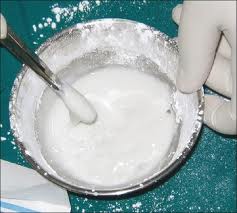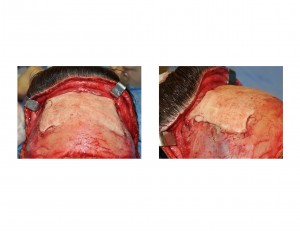Background: Although the forehead occupies almost 1/3 of the entire face, it is the one bony facial structure that is least changed for aesthetic purposes. Chin, cheeks, noses and jaw angles are far more commonly surgically altered than the much larger forehead.
The most common forehead change is augmentation of a flat or recessed forehead shape. When doing so it is important to take into consideration the gender of the patient. Women desire a more convex forehead shape that has a more vertical inclination. Men desire a stronger brow bone appearance with a brow bone break into a more oblique or backward forehead inclination to the hairline.
Forehead augmentation requires two elements, an open coronal scalp incision for access and a synthetic material to add to the bone. Forehead augmentation materials include PMMA (acrylic) and hydroxyapatite (HA) powder and liquid compositions as well as preformed implants made from a 3D CT scan. Most commonly the liquid and powder compositions are used due to their lower cost and the lack of any need for preoperative CT scanning.

Case Study: This 35 year-old female wanted more prominent brows and forehead projection for her naturally flatter forehead. She specifically wanted a conservative augmentation of about 5 to 6mms of increased projection (forehead/brow augmentation) and wanted to use hydroxyapatite material.


The most natural material for forehead augmentations is hydroxyapatite. (HA) Studies have shown that bone does bond directly to the material without a fibrous (scar) interface. However due to its higher cost it should be reserved for use in more modest forehead augmentations. When pronounced or significant volumes of material are needed for a large area like the forehead, PMMA offers an effective and economical alternative bony material.
Case Highlights:
1) Forehead augmentation in females is done to improve the shape of a flat forehead to a more convex one.
2) Forehead augmentation requires the application of a synthetic material of which the most common are the intraoperatively-shaped bone cements.
3) The most natural synthetic material for forehead augmentation is an hydroxyapatite composition which is a non polymer-based material.
Dr. Barry Eppley
Indianapolis, Indiana


